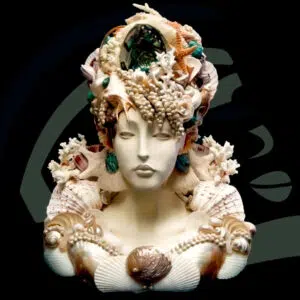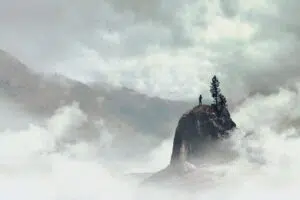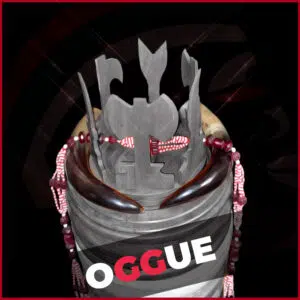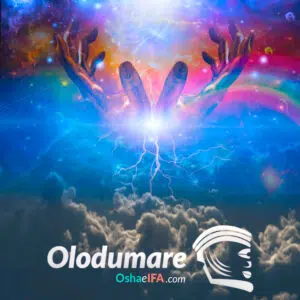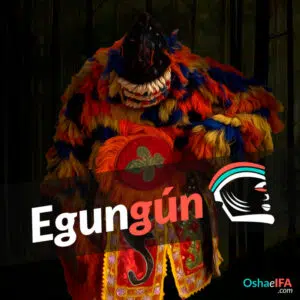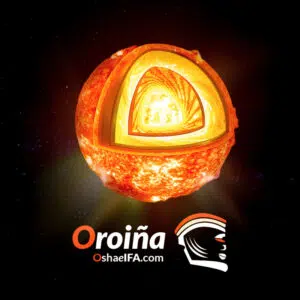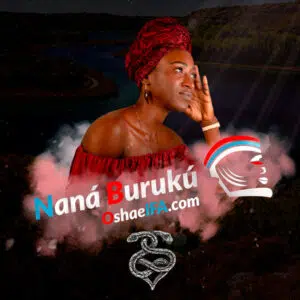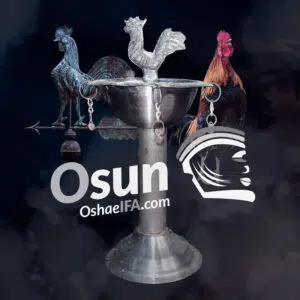Ochosi: The Orisha hunter who represents Justice
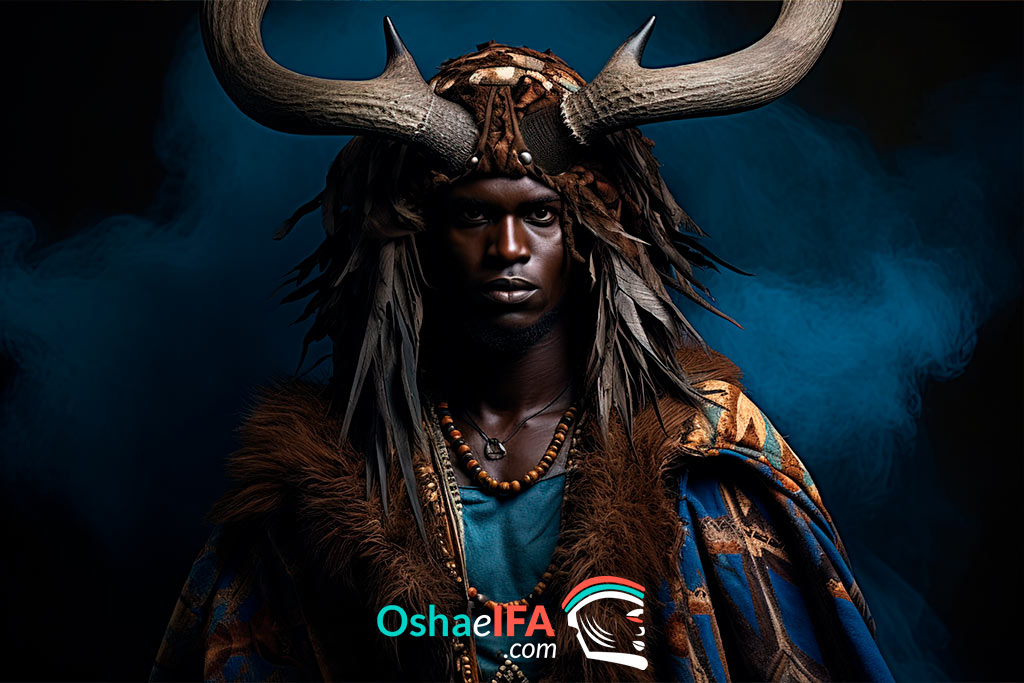
Ochosi is one of the main Orishas in Yoruba mythology, recognized as the deity of hunting and justice. Historical records give him the title of king of the region known as Ketu. This divinity holds great importance not only for the Yoruba people, but also for believers of Afro-Caribbean religions such as Santeria, Palería and Candomblé.
These different traditions offer different lineages for him. While some consider him the son of Oduduwa, in the Rule of Osha and Ifá, he is considered the son of Ode Mata; in other versions, he is the son of Obatalá and Yembó or Yemú (the first Yemaya).
Who is Oshosi?
Ochosi, also known as Oshosi, is a Yoruba Orisha who symbolizes balance in all its forms. He stands out for his special involvement in the spiritual alignment of the forces of nature and ancestral spiritualities, having a significant influence on people to help them align with their destinies.
This eternal hunter also personifies true friendship, brotherhood and solidarity. He is part of the trilogy of the "warriors" group, which includes Elegua and to Oggun, the latter being his inseparable friend. His energy resides in prisons and in all places where justice is administered, and he lives in the thickness of the mountain.
His name is translated as: Osó = sorcerer, Sísé = to do work, Sí = to; that is to say: "The one who works for witchcraft"; he is considered a healer and a fortune teller.
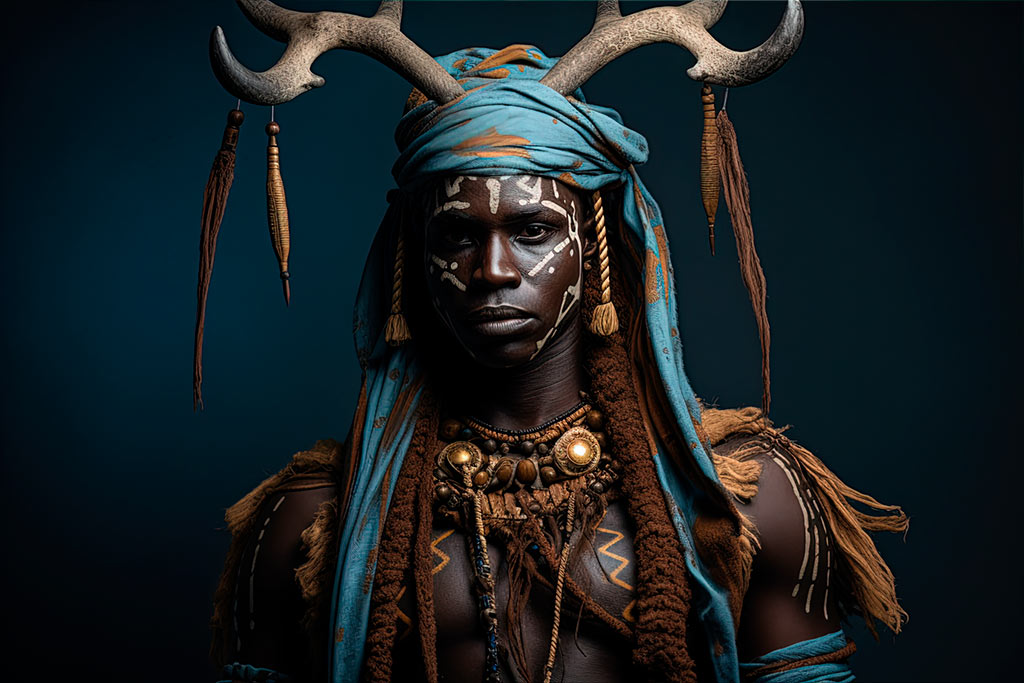
Ochosi is portrayed as a strong and agile man, with a deep knowledge of the natural world that allows him to be an expert healer and sorcerer. His actions are imbued with justice, truth, sincerity and loyalty. Although he possesses a brash and impulsive side, he is a loyal friend. He never overlooks a fault, no matter who it is, and he can't be bought or bribed. He acts only for the benefit or harm of those who deserve it, and when he punishes a fault he can be lethal.
It is in this virtue that his righteous spirit is revealed. Helping individuals to reach their destiny, it acts as a guardian, eliminating situations, setbacks or even people that could prevent them from successfully developing their goals on their way through the earth. This great responsibility implies that he promotes phenomena, no matter how painful or incomprehensible they may be, with the sole objective of benefiting individual growth and removing any obstacle that may hinder it.
Ochosi, the righteous hunter of the Yoruba Religion
It is necessary to emphasize that said attribution justified "no" was granted to him for the fact of having killed his mother as a result of ignorance of his fault and his impulsiveness, when she had the birds that he hunted for Olofin, fired his arrow to punish who he considered a simple thief, ignoring his identity. Such an event, on the contrary, reveals an impetuous and resentful nature that ultimately had to be appeased by the Orisha himself in acknowledging his mistakes.
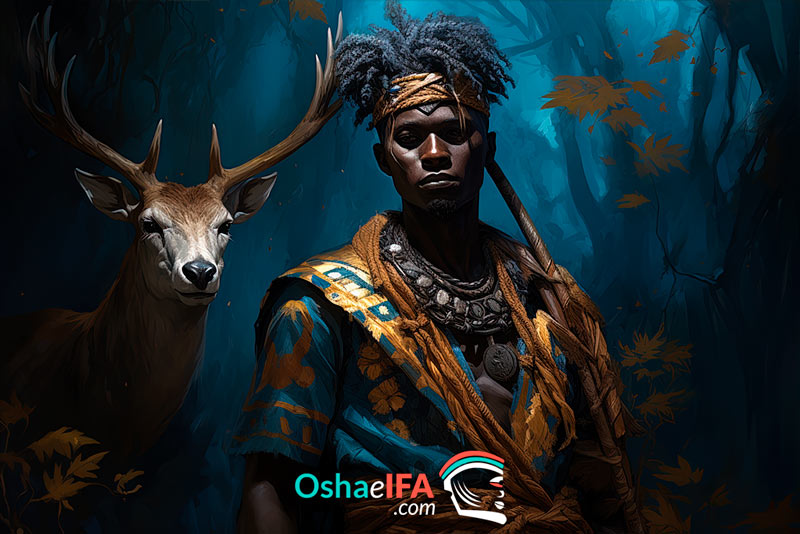
Therefore, this Orisha embodies two different facets, such as the scales, which were perfectly balanced, making it a fundamental part that fosters harmony between the spiritual and earthly energies of the existential planes.
Due to his righteous nature, some consider him a representative of divine justice. Therefore, it is crucial to carefully consider when asking for his help, making sure that the request is fair, as his energy dispenses justice with complete impartiality, regardless of who makes the sacrifice.
Ochosi is an expert in flora and fauna. He possesses an Ashe that grants him unerring aim. Likewise, he pays attention when he is called upon in times of need, to provide basic necessities such as food and shelter. He symbolizes alliances, teamwork, balance in nature, balance between the earthly and spiritual world, freedom, evolution, skill in the use of tools, progress, unconditional love, solidarity, and union between peoples.
Characteristics of Ochosi
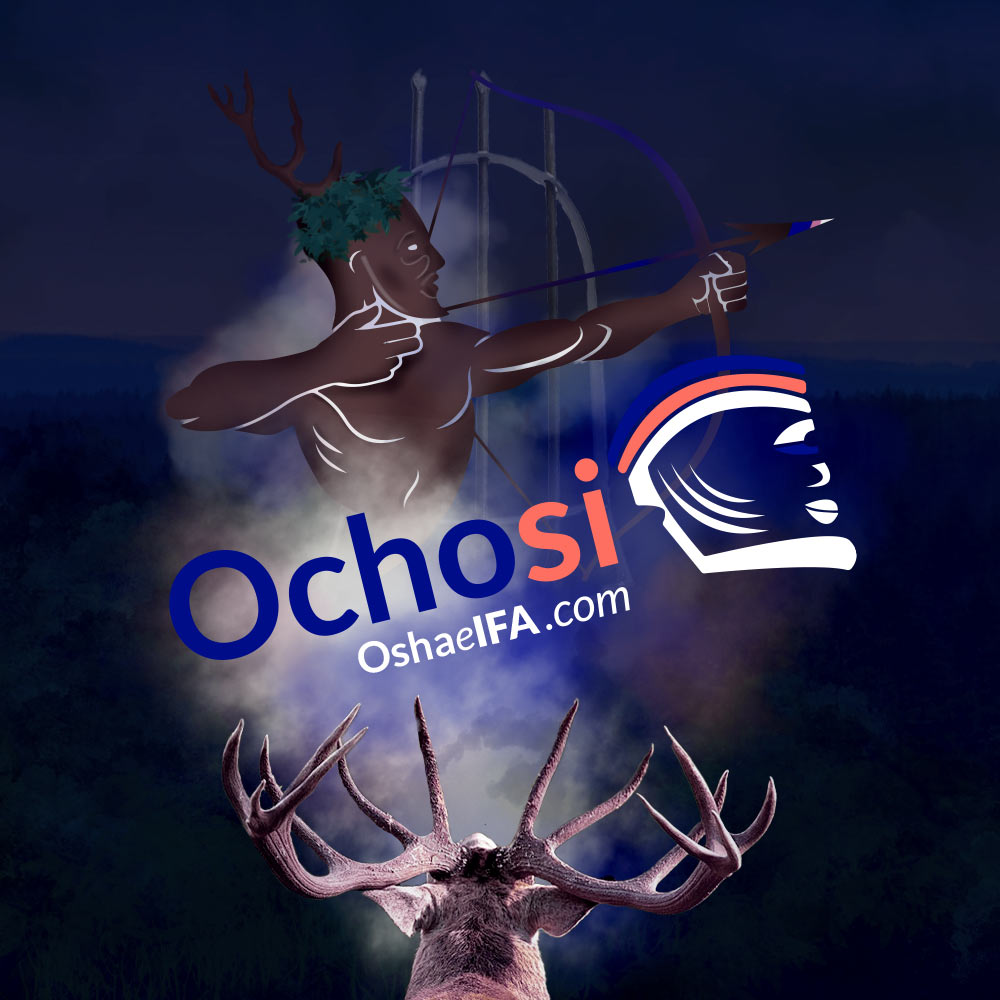
Oshosi, in addition to being a vigilante and a hunter, is also a skilled healer, fortune-teller, and fisherman. He is a friend of the Orisha Osaín, from whom he learned the secrets of herbs, sticks and tree roots; he also enjoys a good friendship with the Orisha Inle, who taught him the secrets of medicine and fishing.
Its first foundation given in the rule of Ifa when the initiate receives the "hand of Orula" is composed of an Ota (stone) accompanied by a bow and arrow, which sits inside a cauldron where the energy of Oggún also rests. In the Osha rule, its foundation is enshrined on a fryer or clay rubber containing the Ota, bows, arrows, a hand of cowrie shells and other tools used by the Orisha. The accompanying attributes are hunting and fishing instruments, deer jars, three hunting dogs, hooks, mirrors, and shields. Your bows and arrows should never be pointing down, as you are always alert and in a hunting position. In some branches they usually cover their foundation with a blue or leopard cloth.
Day:
The anniversary of the Orisha Ochosi is celebrated on November 3 thanks to syncretism. His day of the week is Tuesday.
Number:
Oshsi's number is 3, 7 and their multiples.
Necklaces (elekes) and colors of Ochosi

His necklaces and his ildé (bracelet) are made with two alternating threads of colored beads: blue, green, amber, and orange, colors that identify him. Her clothing and accessories include knee-length trousers, a hat, a cape, and a crossbody bag across her chest. His costume is usually made with leopard skins, sackcloth, blue, green and orange fabrics, adorned with beads and cowries.
Oshosi dances
When this Orisha dances through a saint's horse at a ritual feast, she performs skillful and energetic movements, stands on one foot, takes a hunting position, keeps her fingers crossed, and performs movements with her hands that simulate the shooting of the arrow using the bow. Their advice is listened to with great respect because it is usually considered a sentence.
History of Ochosi
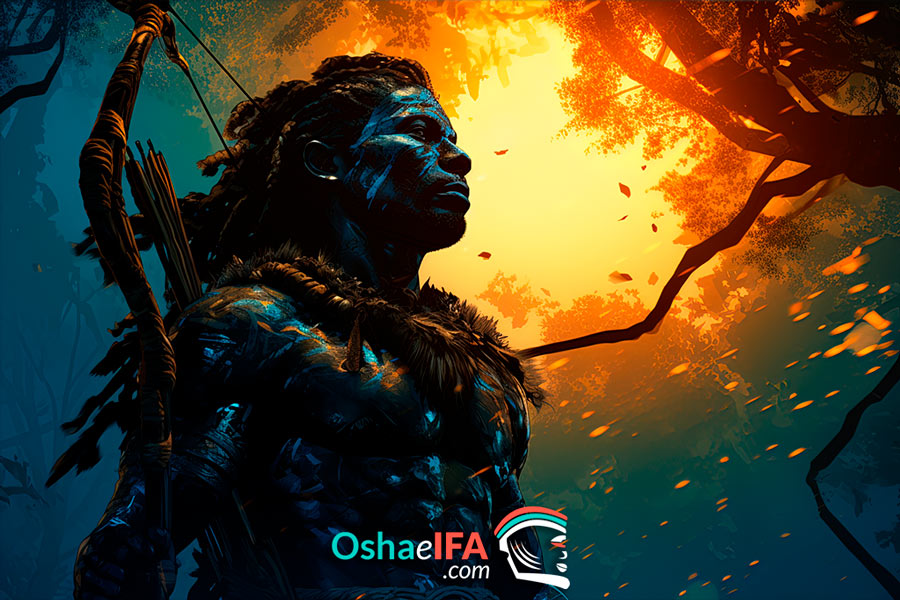
Oshosi was concentrating on catching quail to offer to Olofin. Every time he gathered three of them, someone would steal them from his cage, repeating this situation several times. When he managed to offer a quail to Olofin, he told him to "make a wish and it would be granted." The hunter full of rage mounted his bow and arrow and asked that his arrow pierce the heart of whoever stole the quail, which was granted.
Hidden in the bush was Yemú, who out of charity freed the Oshosi quail. The arrow traveled until it pierced his heart. When Olofin saw her perish, he was surprised and told Ochosi that he had killed his wife, that is, his own mother.
Bewildered, scared and distressed, Ochosi ran non-stop for many days, while so much water gushed out of Yemú's heart that rivers and then seas formed. Exhausted Oshosi fainted on the seashore being awakened by Yemaya's voice telling him: «You need time to pass so that things can be fixed. Go to Oshun and stay with her.
Oshún, who was living with Inle at that time, welcomed him. After several years, Yemayá went looking for him to take him to the foot of Olofin. Upon arrival, Oshosi very sorry he apologized for what had happened. Olofin, after listening to him, sentenced him to work forever with his brother Oggún, which he accepted without question, only begging him to allow him to place blue and yellow beads on his necklace in recognition of the help he received from Yemaya and Oshun. Olofin agreed, adding that he would also place three cowries to remember the three quails for which he took the life of his mother.
What is asked of Ochosi?
Ochosi is asked to help us find the right path to fulfill the positive of our destinies. It is excellent for providing the energy that brings harmony between the spiritual and earthly world of the existential planes. She is an opportune Orisha to implore her for the development of the ability to control one's own energies that manifest in individuals such as: impetus, resentment, and all the uncontrolled and disproportionate emotions of the human being.
It is also an excellent protector in cases that need healing and healing, both physical and spiritual, since he is considered a healer and fortune teller. Finally, he is well known for intervening in situations in which justice actions are required, which is why he is invoked to protect individuals only when they are victims of unfair situations.
What are Ochosi's children like?
Their children are usually very friendly, sympathetic, charismatic, caring, intelligent, cunning, individualistic, independent, creative, self-taught and skilled in manual work, loyal when they really want to.
Ochosi's children have a natural grace that makes them quick-thinking and intuitive, usually more skillful than the rest, a virtue that they can sometimes use erratically, becoming explosive people who want to attract the attention of others at any cost, they It takes a lot to mature, they can be rebellious, resentful, transgressors of the norm, rough to say things, disorderly, fickle, stubborn and given to illicit businesses.
Names for Ochosi's children
- YENKU: Oshosi won't let me die.
- ALANKUA: Ochosi's mighty arm.
- ODE MELE: The compassionate hunter.
- DAYEN: Ochosi is on earth.
- OTUMBU WING: Ochosi's cloak of absolute truth.
- KEPEZO: Ochosi holds me.
- ENI OWO: The prestigious son of Ochosi.
- OMO LADA: The son with the crown of Ochosi.
- OMO NIYI: The son of the glory of Oshosi.
- OSHOSI OMO ELETIRO: The correct son of Oshosi.
- OMO KOYE: The mysterious son of Oshosi.
- OMO LAPPA: Ochozi's diligent son.
Relationship between the Orishas Oggun and Ochosi
The following story or pataki tells why Oggun and Ochosi are deities that stay together and how important it is to attend to their foundations together.
The union of Ogun and Oshosi (Patakie de Ogunda La Masa)
It happened that the Orisha oggun He handled the ada (machete) very well but in the same way, it was difficult for him to reach his hunting objective in the thick of the forest on time, any delay or noise caused the animals to escape on time, which made it difficult for him to hunt . For his part, Ochosi easily hunted his prey but had a hard time getting to the place where he was to rescue him from the undergrowth.

Each of them separately went to Orumila for Osode (divination) to be performed in order to solve their problem. Ifa determined that both should make Ebo (sacrifice), which they diligently performed. Then, they went out to place it at the foot of a tree indicated by Orumila as the final destination of the ebo. When both men found themselves in that place they felt unwell at first, because despite not knowing each other, Eshu had already commented on the existence of the other, highlighting in each story the virtues that one had over the other, for which they were predisposed.
However, once the spirits were calmer, they began to talk about the bad situation that both were going through when they could not reach their food in a satisfactory way. Oshosi observed a deer in the distance, firing his arrow and hitting his prey as usual, indicating to Oggún that "he could easily hit it, but he could not reach it because of the intricate mountain that stood between him and his prey." Oggún replies that "that was no problem" leading the way with his machete in the forest, quickly reaching the body of the deer. Both very happy to have food, they celebrated, cooked and ate that food together. Since then they have been inseparable when they make a pact thanks to divination and the ebo determined by Orumila that they would always work together "in union there is strength."
This story teaches us that while each individual may have unique abilities and talents, sometimes these are not enough to overcome all obstacles on their own. It is teamwork and collaboration that often leads to success. We must not allow comparisons and jealousy to make us forget the value of fellowship and cooperation. Instead of competing with each other, we must recognize that combining our strengths can help us overcome our weaknesses and achieve our goals.
Pataki of Ochosi:

On an ancient path, Ochosi, God of the hunt, worked hard to provide prey for the other deities. However, his work was not rewarded, his pocket remained empty and his spirit tired. Looking for a solution to his misfortune, the hunter decided to seek the wisdom of Orunmila.
Once in the presence of Orula, Oshosi related his dilemma. Orunmila's advice was clear and direct: he should betray the other Orishas and give them the wrong prey. Obeying, the hunter delivered wrong prey, however, the trick turned against him. Instead of punishing the Orishas, he seemed to benefit them even more, and their situation became even more desperate.
In search of another solution, Ochosi went to see Olofin, the supreme ruler. The recommendation was simple: he should change his trade and place, he should become a blacksmith in another town. Following this new path, the hunter became a blacksmith and found employment with Oggun. He worked diligently, learning the art of iron and steel.
But fate had more in store for Oshosi. He wandered from town to town, absorbing knowledge and skills, becoming a jack of all trades. Meanwhile, Olofin was looking for a complete man, a man of multiple abilities, to govern a town. Many applied, but they were all experts in a single field.
When Ochosi found out about this search, he appeared before his creator. Seeing that this hunter-turned-blacksmith had acquired a multitude of skills, Olofin, with his divine word, appointed Ochosi as King. Thus, the hunter who once worked without reward ascended the throne, thanks to his wisdom and his bravery.
Ochosi in the Catholic religion (Syncretism)
In Ochosi's syncretism it is very interesting. This Orisha is related to various saints of the Catholic religion. The most outstanding ones with which it is usually syncretized are: San Norberto, San Alberto Magno and with Santiago el Mayor.
In the case of San Norberto the similarities are a bit scarce. Norberto's conversion and dedication to the exercise of Catholic evangelization stands out, even going so far as to found important orders at the service of the church in remote places. Like Oshosi, his actions led him to repentance and before reflection he dedicated his life to spiritual work and helping others.
In the case of San Alberto Magno, who holds the title of "doctor of the Church", bishop of great notoriety for his performance as theologian, geographer, philosopher, and chemist in medieval times. It agrees in a great sense because of their common abilities regarding the knowledge of the properties of herbs and stones (minerals). Alberto Magno is the author of a great variety of botanical, astronomical, astrological, mineralogical, alchemy, zoological, justice, law, friendship and love research. Fields in which the spiritual action of Oshosi undoubtedly intervenes.
A great mystery surrounds Albert the Great, which is undoubtedly the reason why it was considered one of the appropriate spiritualities for Oshosi's syncretism. After his death, many myths were generated that attributed knowledge of alchemy, even classifying him as a wise magician, characteristics that are clearly related to the Orisha. It is said that he came to discover the philosopher's stone by inheriting it from his disciple Thomas Aquinas, but there is no proof of this. However, by affirmation of Alberto himself, he witnessed the creation of gold by "transmutation", demonstrating this statement, his knowledge of alchemy.
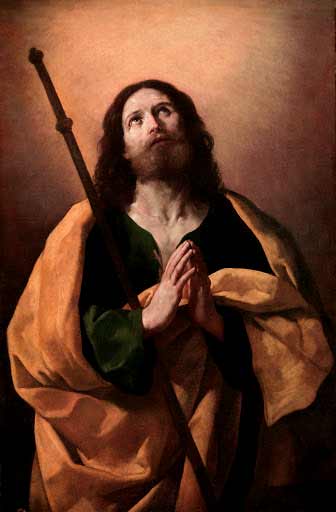
Even so, there is another character with whom the Orisha Oshosi is syncretized whose attributes are more intensely related. Known in the Catholic religion as: Santiago de Zebedeo or Jacobo de Zebedeo, he is one of the most outstanding apostles who accompanied Jesus of Nazareth, considered one of the three columns of the Church of Jerusalem in the company of the apostles John and Peter (syncretized with Oggún). Ochosi, likewise, belongs to the warrior trilogy accompanied by Elegua and Oggún.
Santiago is represented as a pilgrim. When the Yorubas arrived in America, they adapted some basic attributes of the pilgrims for the use of the warrior Orishas, such as: the pilgrim's staff (Garabato), the pilgrim bag (hanging güiro) and the Pilgrim hat (typical hat of yarey). Elements that indisputably lead us to find similarities between these two spiritualities. In another sense, Santiago is also represented as a soldier on horseback in a fighting attitude, further relating his virtues to Ochosi, conceived as a warrior by nature.
The spiritual influence of Santiago in the war is evidenced thanks to the fact that the success of King Ramiro I over the Moors in Clavijo in 844 is attributed to him, where his appearance is affirmed, from that event he is known as "Santiago Matamoros" defender of Catholics in the wars against the church and its followers; in Spain, Santiago el Mayor is the patron of the Army Cavalry Weapon. In the same way, the spiritual influence of Oshosi is invoked for the struggles under which the Yoruba people have been subjected, due to their warrior and justice character.
Prayer (Prayer) to Ochosi
yá ku o. Ode shá kuelé. Adé shá kuelé.
Oshá, níbebé, oko ní de, bo baré ná
Eri ki ya na
Ya kuo Ade shá kuelé. Odé shá kuelé.
A babi olosha. A fa rí baby. A farí baby
Oko ní de, bo baré ná;
Eri ki ya na
Traducción:
I quickly greet you. Light cut hunter. Crowned slightly slashing.
Owner of the riverbank, throw the razor to hunt fur, position the ambush and trap first.
I salute the head that opens the way for a relative.
I quickly greet you. Light cut hunter. Crowned slightly slashing.
We meet for the birth of a selected one. That's why we don't shave our heads. We shave our heads.
Spear hunting, positions in ambush to jump and catch first.
ORÍKÌ ÒSOÒSI
(Praising the Male Spirit of the Hunter)
Àrà l 'ème n f 'Òsóòyes da. Àrà nì n f 'Òsóòyes da.
Summons are my offering in the trade with Osoosi. Summons are my offering in the trade with the Spirit of the Hunter.
Gbogbo ìsòwò ibi no b 'oof dé rèé o. Àrà nì n f 'Òsóòyes da. TOse.
You are all companions of the hunter, this is why I have come from a distant place to hunt. Summons are my offering in the trade with Osoosi. Asé.
I sing to Ochosi
Akuon:
Oshosi ayiloda mala mala ode.
yire yire
Traducción:
Oshosi would be good if he took bad luck for hunting.
Good luck
Chorus:
Odé kills wole wole.
Traducción:
Before the spirit of the hunter you have to turn your back.
Akuon:
Yabeleke iwoo Odé mata odé fa.
Odé fa odé kills.
Traducción:
His mother faced the spirit of the hunter and he shot her.
The hunter and the arrow, the hunter.
Chorus:
Iwalá ode fa.
Traducción:
Arrow to us.
How is Ochosi mounted by ifá?
This Orisha is delivered by both santeros and Babalawos. When it is delivered by Babalawos or "from Ifa" it is made on a clay rubber with a secret load that is then cemented, it carries the most iconic tools of the Orisha (bow and arrow).
Works with the Orisha Ochosi
Work with Oshosi to free us from the enemy
(It is important to remember that to ask Ochozi to free you from the enemy, you must be absolutely innocent in the face of the conflict that arises, otherwise you may also be harmed by the action of the Orisha, which is fair in its entirety)
The names and surnames of the enemy are written on a piece of paper, a lot of vinegar, red precipitate, soil from a roof and peppers are placed in a saucepan. This is presented at the foot of Ochosi to drive away that enemy. After giving account, it is placed inside a bottle and to the next three it is buried.
Spell with Oshosi to get true love
Ochosi is blown toasted corn powder crushed with white sugar and his alcoholic beverage aniseed. Giving him knowledge that this work is going to be done to ask for his divine intervention to achieve true love. With a chicken egg that has been smeared with shell, cocoa, honey and corojo oil, the entire body of the person is cleaned, then the egg is placed at the foot of the Orisha and two quails are fed. Finally, the egg and the quail are carried wrapped in a blue cloth to the destination indicated by the Orisha.
Oshosi phrases
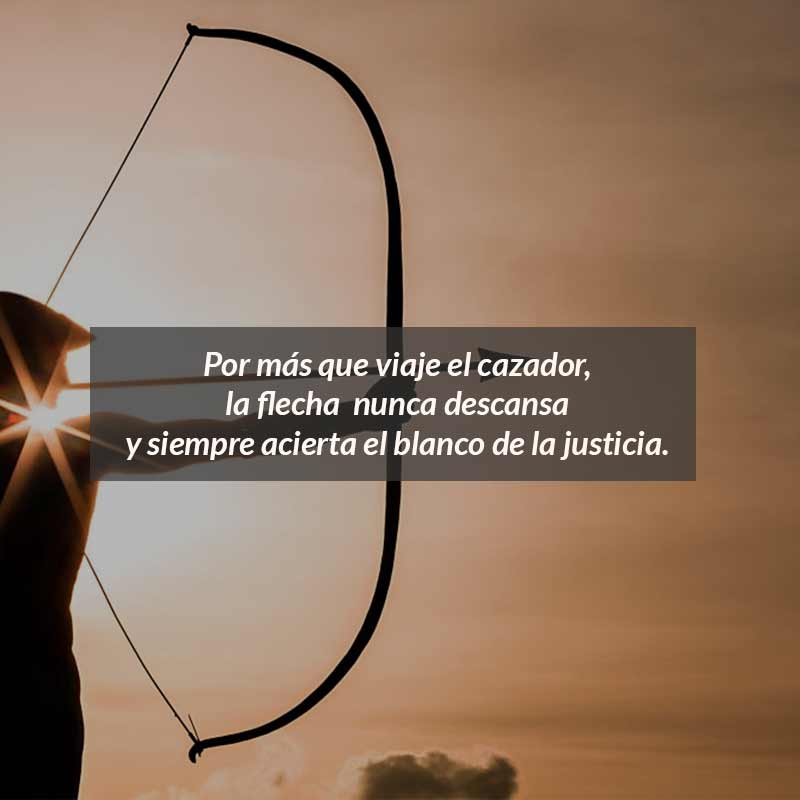
- No matter how much the hunter travels, the arrow never rests and always hits the target of justice.
- A hunter never forgets the good that has been done to him, just as he does not forgive those who pay with bad thanks.
- Sooner or later the traitor is caught by the arrow of justice.
You want to learn more about the Orishas of the Yoruba religion:

